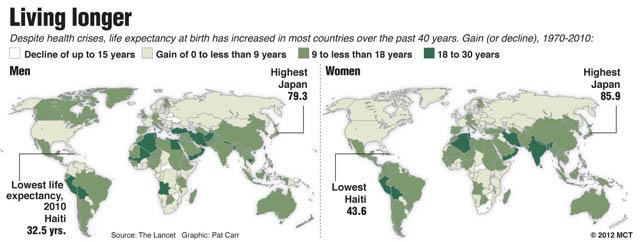You are here
Global life expectancy rises
By AFP - Dec 22,2014 - Last updated at Dec 22,2014
PARIS — People around the world lived on average to a ripe old age of 71.5 in 2013, up from 65.3 in 1990, a recent study said, noting the gains came despite big increases in liver cancer and chronic kidney deaths.
Global life expectancy rose by 5.8 years in men and 6.6 years in women between 1990 and 2013.
The increase was attributed to falling death rates from cancers (down by 15 per cent) and cardiovascular disease (down by 22 per cent) in high-income regions of the world.
In less affluent regions, it was attributed to rapidly declining death rates for diarrhoea, lower respiratory tract infections and neonatal disorders, the study published in British health journal The Lancet said.
Only one region, sub-Saharan Africa, did not benefit from the upward trend with deaths from HIV/AIDS resulting in a drop in average life expectancy of five years.
“The progress we are seeing against a variety of illnesses and injuries is good, even remarkable, but we can and must do even better,” lead author Dr Christopher Murray, professor of Global Health at the University of Washington, said.
“The huge increase in collective action and funding given to the major infectious diseases such as diarrhoea, measles, tuberculosis, HIV/AIDS and malaria has had a real impact,” he added.
The study found, however, that death rates from some major chronic conditions were on the rise, including liver cancer caused by hepatitis C (up 125 per cent since 1990), drug use disorders (up 63 per cent), chronic kidney disease (up 37 per cent), diabetes (up 9 per cent) and pancreatic cancer (up 7 per cent.
The Global Burden of Disease Study 2013, funded by the Bill & Melinda Gates Foundation, also found that some low-income countries such as Nepal, Rwanda, Ethiopia, Niger, the Maldives, Timor-Leste and Iran had seen exceptional gains over the past 23 years with life expectancy in those countries rising by more than 12 years for both sexes.
In India too, good progress had been made on life expectancy, with a rise of almost seven years for men and just over 10 years for women between 1990 and 2013.
But the study noted that suicide was a growing public health problem in India with half the world’s suicide deaths alone occurring in India or China.
And despite dramatic drops in under-five deaths from 7.6 million in 1990 to 3.7 million in 2013, the study also noted that lower respiratory tract infections, malaria, and diarrhoeal disease were still in the top five global causes of child deaths, killing almost 2 million children a year.
Related Articles
There may be plenty of room for debate about whether some aspects of everyday life cause cancer — whether it’s drinking too much coffee, eat
Although life expectancy among Jordanians witnessed an increase in 2010 compared to two decades earlier, the Kingdom is still threatened by the rise in chronic diseases, diet-related risk factors, and road deaths, according to a study released this week.
LONDON — Obesity could overtake smoking as the chief avoidable cause of cancer-related deaths, the world’s largest independent funder of can














